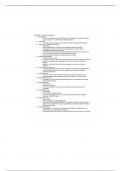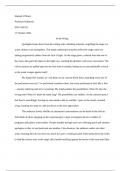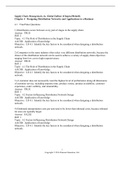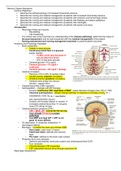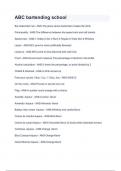● Management
○ The act of working with and through a group of people to accomplish a desired
goal or objective in an efficient and effective manner.
● Leadership
○ The ability to drive change and innovation through inspiration and motivation.
● Bureaucratic organization structure
○ Max Weber
○ a clear differentiation of tasks and responsibilities among individuals
○ coordination through a strict hierarchy of authority and decision rights
○ Standardized rules and procedures
○ the vertical separation of planning and execution so that plans are made in the
upper ranks of an organization and executed in the lower
○ he use of technical criteria for recruitment and promotion
● Scientific Management
○ Frederick Taylor - 1910’s
○ focused on how jobs, work, and incentive schemes could be designed to improve
productivity using industrial engineering methods such as time and motion
studies.
○ likened to a well-oiled machine and the manager was seen as a machine
operator.
● Human Relation Movement
○ The belief that organizations must be understood as systems of interdependent
human beings who share a common interest in the survival and effective
functioning of the firm.
● Contingent View
○ A view of the firm where effective organizational structure is based on fit or
alignment between the organization and various aspects in its environment.
● Business Environment
○ combination of all contextual forces and elements in the external and internal
environments of a firm.
● Managerial View
○ Up To 1960’s
○ Focus On production
○ firm as a mechanism for converting raw materials into products to sell to
customers.
● Shareholder View
○ 19060-1980
○ Focus on financial performance
○ the job of top managers was to produce the highest possible stock market
valuation of the firm’s asset
● Stakeholder View
○ Since 1990’s
○ Focus on Serving multiple stakeholders
○ A business framework that identifies and analyzes multiple groups that interact
with the firm and attempts to align organizational practices to satisfy the needs of
these various groups.
● Stakeholder Theory
○ a stakeholder is any group or individual who can affect or is affected by the
achievement of an organization’s purpose.
○ concerned with who can influence a firm’s decisions and who benefits from those
, decisions.
● Strategic Review Process
○ process by which senior leaders of a corporation meet with business unit
managers to review progress toward specific goals.
● Environmental Scanning
○ A tool that managers use to scan the business horizon for key events and trends
that will affect the business in the future
● Scenario Building
○ Forecasting the likely result that might occur when several events and
stakeholders are linked together.
● contingency planning
○ the manager typically assigns probabilities to these alternative futures
and begins to map out a series of preemptive action steps to prepare
the firm.
● Trend Analysis
○ key variables are monitored and modeled to help predict a change that might
occur in the environment.
● Contextual Intelligence
○ Managers understand the impact of environmental factors on their business
operations, and they understand how they can influence or react to those same
factors.
CHAPTER 2. The Global Business Environment
● Globalization
○ the integration and interdependence of economic, technological, sociocultural,
and political systems across diverse geographic regions
● Global Trade Agreements
○ International Monetary Fund (IMF)
○ World trade
■ defined by the value of the world’s merchandise exports
○ supported through a series of free trade agreements negotiated between various
countries and overseen by the WTO.
● External Environment
○ represents all of the external forces that affect the firm’s business.
○ Divide a firm’s external environment into two separate components
■ General Environment
● Technological
○ processes, technologies, or systems that a firm can use to
produce outputs.
● Economic
○ GDP, inflation, unemployment, consumer sentiment, and
interest rates of all the countries where it sells its products
and services.
● political/legal
○ political events and activities in a market that affect a firm.
Firms that operate on a global scale experience significant
political pressures in their business.
○ regulations and laws that a firm encounters in its markets.
● sociocultural dimensions
○ demographic characteristics as well as to the values and
customs of a society.

